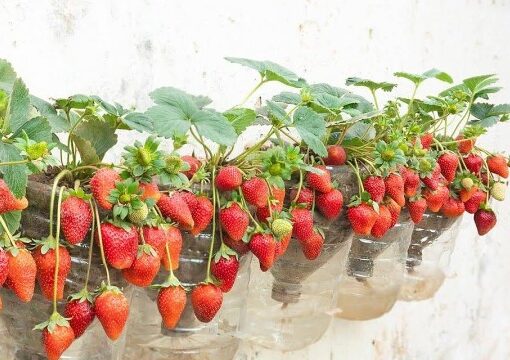There’s something uniquely satisfying about plucking juicy, red strawberries straight from your own container garden. Not only does it infuse your space with vibrant greenery, but it also offers the unparalleled delight of homegrown sweetness. In this comprehensive guide, we’ll take you through each step of cultivating strawberries in containers, ensuring a fruitful harvest in even the smallest of spaces.

Step 1: Selecting the Perfect Strawberry Varieties
Choosing the right strawberry varieties lays the groundwork for a successful yield. Consider factors like space availability and your preference for June-bearing, everbearing, or day-neutral varieties.
Opt for compact or trailing varieties like Alpine or Ozark Beauty, ideally suited for container gardening due to their adaptability and flavor burst.
Step 2: Setting Up Soil and Containers
Creating an optimal environment for your strawberries starts with the soil and containers. Use a well-draining, nutrient-rich potting mix to foster robust root growth. Repurpose 5-liter plastic bottles by cutting them horizontally, leaving the bottom intact as a water reservoir, and drilling drainage holes in the cap end.
This eco-friendly approach not only minimizes waste but also provides an ideal habitat for strawberry plants.
Step 3: Planting Your Strawberries
Planting strawberries in containers requires careful attention to detail.
Ensure the soil is moist but not waterlogged before planting, and position the strawberry plants with the crown just above the soil surface. Maintain adequate spacing between plants, roughly 8–12 inches apart, if planting multiple strawberries in one container. Water thoroughly post-planting to encourage root establishment.
Step 4: Providing Care for Your Strawberries
Watering: Consistent soil moisture is crucial for optimal fruit production. Water your strawberry plants regularly, especially during flowering and fruiting stages, ensuring the soil remains lightly moist but not soggy.
Fertilizing: Strawberry plants thrive on nutrients, so prepare the soil with aged manure or compost beforehand. Maintain a slightly acidic soil pH (6 to 6.5) and supplement with a balanced fertilizer every three to four weeks during the growing season.
Pruning: Regular pruning is essential to remove any diseased or unwanted parts of the plants, including leaves, stems, flowers, or runners.
Step 5: Harvesting Your Bounty
Once your strawberries reach a deep red hue, harvest them gently, leaving the green cap intact for freshness. Morning harvests are optimal for the best flavor, and avoid pulling the berry by the cap or calyx to prevent damage. Enjoy your freshly picked strawberries immediately or preserve them through freezing or making preserves for prolonged enjoyment.
Key Considerations to Keep in Mind
- Sunlight: Ensure your containers receive a minimum of 6 hours of sunlight daily, rotating them occasionally for even exposure.
- Pest and Disease Management: Monitor for common pests and diseases like aphids, powdery mildew, and fruit rot, employing organic pest control methods or crop rotation as needed.
- Container Maintenance: Regularly inspect and replace worn or damaged plastic bottles to ensure a healthy growing environment for your strawberries.
In conclusion, cultivating strawberries in containers offers a rewarding gardening experience from start to finish. From selecting the right varieties to nurturing your plants and indulging in the fruits of your labor, this journey embodies the essence of homegrown goodness. So whether you’re a seasoned gardener or a novice enthusiast, dive into the world of container gardening and savor the sweetness of freshly grown strawberries.
Share via:
